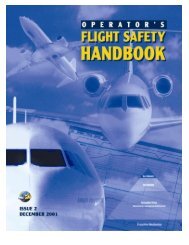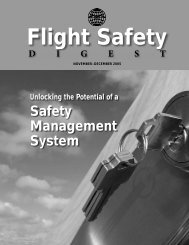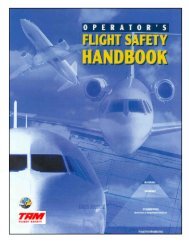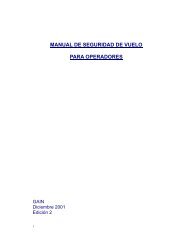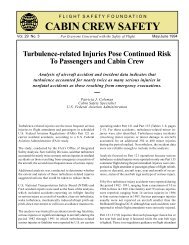Download PDF [10.9 MB] - Flight Safety Foundation
Download PDF [10.9 MB] - Flight Safety Foundation
Download PDF [10.9 MB] - Flight Safety Foundation
You also want an ePaper? Increase the reach of your titles
YUMPU automatically turns print PDFs into web optimized ePapers that Google loves.
from 10 to 6, and “undetermined” excursions —<br />
for which it was not possible to determine from<br />
reports which phase they occurred in — fell<br />
from 10 to 2. In total, the number of excursions<br />
from 2010 to 2012 decreased from 98 to 57, or<br />
42 percent.<br />
In each year, landing excursions outnumbered<br />
takeoff excursions by a considerable<br />
margin.The majority of excursions — including<br />
both takeoff and landing excursions — were<br />
classified as “loss of directional control” in each<br />
of the study period’s three years, but the number<br />
was reduced each year (Figure 5). The fewest<br />
overruns, both on takeoff and landing, occurred<br />
in 2011.<br />
The number of excursions diminished each<br />
year in the Edmonton, Toronto and Montreal<br />
flight information regions. 8<br />
Notes<br />
1. NAV Canada. Quarterly Runway <strong>Safety</strong> Report. .<br />
2. The report defines a runway incursion as “any occurrence<br />
at an aerodrome involving the incorrect<br />
presence of an aircraft, vehicle or person on the<br />
protected area of a surface designated for the landing<br />
and takeoff of an aircraft.”<br />
3. In the report, a pilot deviation is defined as “an action<br />
of a pilot that results in noncompliance with an<br />
ATC [air traffic control] instruction/clearance or a<br />
violation of a Canadian Aviation Regulation.”<br />
4. The report defines an ATS deviation as “a situation<br />
which occurs when air traffic services are being provided<br />
and when a preliminary investigation indicates<br />
that safety may have been jeopardized, less than<br />
minimum separation may have existed, or both.”<br />
5. A pedestrian or vehicle deviation is defined in the<br />
report as “a situation that occurs when a vehicle<br />
operator, a non-pilot operator of an aircraft or a<br />
pedestrian proceeds without authorization onto the<br />
protected area of a surface designated for landing or<br />
takeoff. This classification includes security breaches<br />
but excludes animals.”<br />
6. The report does not define the distinction between<br />
civil and airline operations.<br />
7. The report defines a runway excursion as occurring<br />
“when an aircraft fails to confine its takeoff or landing<br />
to the designated runway. This may occur during<br />
FLIGHTSAFETY.ORG | AEROSAFETYWORLD | MAY 2013<br />
Canadian Runway Excursions, 2010–2012<br />
Number of incursions<br />
78<br />
64<br />
10 10<br />
8<br />
2010 2011 2012<br />
Landing<br />
98<br />
Takeo Undetermined Total<br />
4<br />
76<br />
49<br />
6<br />
2<br />
DATALINK<br />
Note: An excursion is categorized as “undetermined” when the report did not give sufficient<br />
information to determine the phase in which the excursion took place.<br />
Source: NAV Canada<br />
Figure 4<br />
Canadian Runway Excursions, by Type, 2010–2012<br />
Number of excursions<br />
100<br />
80<br />
60<br />
40<br />
20<br />
0<br />
Source: NAV Canada<br />
Figure 5<br />
Loss of<br />
directional<br />
control<br />
Landing<br />
overrun<br />
Landing<br />
Takeo<br />
overrun<br />
Type of runway excursion<br />
57<br />
Takeo Undetermined<br />
2010 2011 2012 2010 2011 2012 2010 2011 2012 2010 2011 2012<br />
the takeoff roll if the aircraft leaves the runway other<br />
than by becoming fully airborne or if an attempted<br />
landing is not completed within the confines of the<br />
intended runway.”<br />
8. A flight information region (FIR) is an airspace of<br />
defined dimensions extending upward from the<br />
surface of the earth, within which a flight information<br />
service and an alerting service are provided.<br />
The Canadian Domestic Airspace is divided into<br />
the Vancouver, Edmonton, Winnipeg, Toronto,<br />
Montreal, Moncton and Gander domestic FIRs.<br />
The regions are shown visually in the Designated<br />
Airspace Handbook , published by<br />
NAV Canada, p. 177.<br />
Undershoot<br />
on landing<br />
| 47


![Download PDF [10.9 MB] - Flight Safety Foundation](https://img.yumpu.com/18550968/49/500x640/download-pdf-109-mb-flight-safety-foundation.jpg)

![Download this Issue [PDF 7 MB] - Flight Safety Foundation](https://img.yumpu.com/18859635/1/190x245/download-this-issue-pdf-7-mb-flight-safety-foundation.jpg?quality=85)
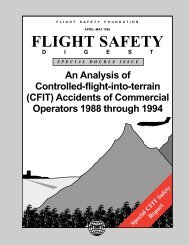
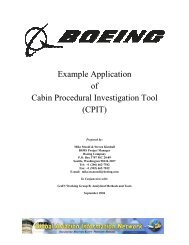
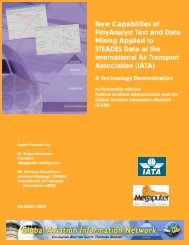
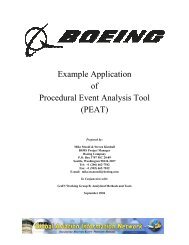

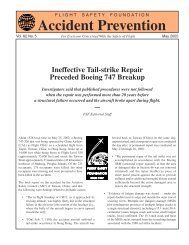
![Download [PDF 8 MB] - Flight Safety Foundation](https://img.yumpu.com/18859366/1/190x245/download-pdf-8-mb-flight-safety-foundation.jpg?quality=85)
